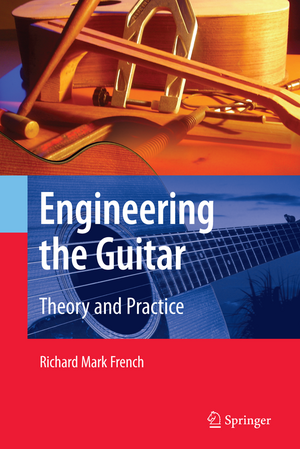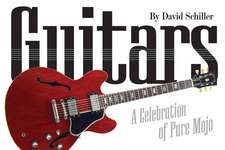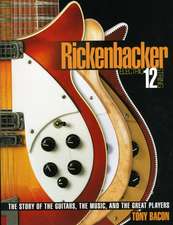Engineering the Guitar: Theory and Practice
Autor Richard Mark Frenchen Limba Engleză Hardback – 23 oct 2008
Audiences interested in mechanics, acoustics, and instrument making will find Engineering the Guitar: Theory and Practice an informative and enjoyable read.
| Toate formatele și edițiile | Preț | Express |
|---|---|---|
| Paperback (1) | 378.54 lei 3-5 săpt. | |
| Springer Us – 5 noi 2010 | 378.54 lei 3-5 săpt. | |
| Hardback (1) | 384.70 lei 3-5 săpt. | |
| Springer Us – 23 oct 2008 | 384.70 lei 3-5 săpt. |
Preț: 384.70 lei
Nou
Puncte Express: 577
Preț estimativ în valută:
73.61€ • 80.21$ • 62.03£
73.61€ • 80.21$ • 62.03£
Carte disponibilă
Livrare economică 02-16 aprilie
Preluare comenzi: 021 569.72.76
Specificații
ISBN-13: 9780387743684
ISBN-10: 0387743685
Pagini: 266
Ilustrații: XII, 266 p. 100 illus.
Dimensiuni: 155 x 235 x 20 mm
Greutate: 0.52 kg
Ediția:2009
Editura: Springer Us
Colecția Springer
Locul publicării:New York, NY, United States
ISBN-10: 0387743685
Pagini: 266
Ilustrații: XII, 266 p. 100 illus.
Dimensiuni: 155 x 235 x 20 mm
Greutate: 0.52 kg
Ediția:2009
Editura: Springer Us
Colecția Springer
Locul publicării:New York, NY, United States
Public țintă
ResearchCuprins
History of the Guitar.- Acoustics and Musical Theory.- Structure of the Guitar.- Dynamic Behavior.- Analytical Models.- Manufacturing Processes.- Sound Quality.- Guitar Electronics.- Unique Characteristics.
Recenzii
From the reviews:
„…[This is the only book] that deals with the engineering aspects of guitars. Thus it serves a real need for scientifically-oriented guitar makers and aficionados as well as those interested in a broad overview of the world of guitars… The overall broad view of the book makes good reading for those interested in the myriad details involve in constructing a string instrument and then evaluating it scientifically, as the author’s personal building experience and knowledge of a wide variety of guitar construction techniques are put to good use… a significant, commendable addition to the guitar literature in a very broad-ranging book on a very important string instrument."
George Bissinger, East Carolina University, EXPERIMENTAL TECHNIQUES (May-June 2009)
“French discusses whether the math models are … sufficient to capture the features of acoustic responses that are highly correlated with good sound quality. In conclusion … this book will help luthiers at all levels think more clearly about how to successfully manufacture guitars of high sound quality. The book … particularly valuable to students of guitar construction and repair. For the rest of us, this book makes interesting reading.” (Leo Beranek, International Journal of Acoustics and Vibration, Vol. 14 (2), 2009)
“Why do guitars sound like they do, and how do you set about making one? These are central questions addressed … in this attractive new book. … The book is well written, and generously illustrated with interesting … graphs. … a unique and special addition to the literature, and it deserves to be widely read. For anyone contemplating construction of a guitar it will surely be indispensible. Physicists and engineers with musical inclinations, as well as guitar players … are likely to be fascinated.” (Peter V. E. McClintock, Contemporary Physics, Vol. 51 (6), 2010)
George Bissinger, East Carolina University, EXPERIMENTAL TECHNIQUES (May-June 2009)
“French discusses whether the math models are … sufficient to capture the features of acoustic responses that are highly correlated with good sound quality. In conclusion … this book will help luthiers at all levels think more clearly about how to successfully manufacture guitars of high sound quality. The book … particularly valuable to students of guitar construction and repair. For the rest of us, this book makes interesting reading.” (Leo Beranek, International Journal of Acoustics and Vibration, Vol. 14 (2), 2009)
“Why do guitars sound like they do, and how do you set about making one? These are central questions addressed … in this attractive new book. … The book is well written, and generously illustrated with interesting … graphs. … a unique and special addition to the literature, and it deserves to be widely read. For anyone contemplating construction of a guitar it will surely be indispensible. Physicists and engineers with musical inclinations, as well as guitar players … are likely to be fascinated.” (Peter V. E. McClintock, Contemporary Physics, Vol. 51 (6), 2010)
Textul de pe ultima copertă
Engineering the Guitar: Theory and Practice uniquely describes the mechanics of the guitar for engineers and craftsmen alike. Complete with informative illustrations, this popular musical volume describes the underlying mechanical concepts behind the guitar, supported by theory and test. A detailed description of guitar electronics, paired with an in-depth analysis of sound quality, appeals to scientific audiences as well as musicians technically apt. Readers will gain an understanding of the technical behavior of the instrument with respect to structural and component dynamics, in addition to the informative treatment of analytical models. Hand made and mass produced techniques are also examined in a chapter devoted to manufacturing processes.
Audiences interested in mechanics, acoustics, and instrument making will find Engineering the Guitar: Theory and Practice an informative and enjoyable read.
Audiences interested in mechanics, acoustics, and instrument making will find Engineering the Guitar: Theory and Practice an informative and enjoyable read.
Caracteristici
Uniquely describes the underlying mechanical concepts of the guitar clearly supported by theory and test Provides a focused mechanical description entirely devoted to the guitar, rather than a broad overview of string instruments Explains the underlying mechanical concepts behind different guitar making methodologies and theories Offers technical and musical audiences an informative and enjoyable read






